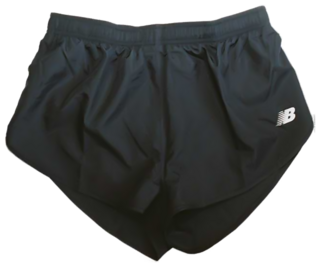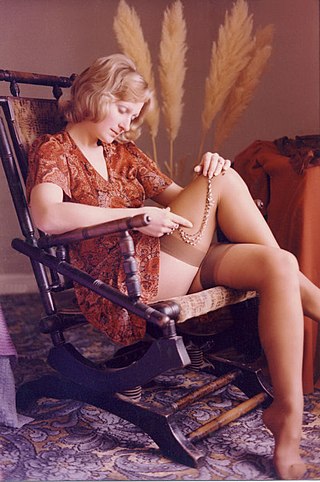
Fetish fashion is any style or appearance in the form of a type of clothing or accessory, created to be extreme, revealing, skimpy, or provocative in a fetishistic manner. By definition, most people do not wear these styles; if everyone wears an item, it cannot have a fetishistic, special nature. They are usually made of materials such as leather, latex or synthetic rubber or plastic, nylon, PVC, spandex, fishnet, and stainless steel. Some fetish fashion items include: stiletto heel shoes and boots, hobble skirts, corsets, collars, full-body latex catsuits, stockings, miniskirt, crotchless underwear, jockstraps, diapers, garters, locks, rings, zippers, eyewear, handcuffs, and stylized costumes based on more traditional outfits, such as wedding dresses that are almost completely see-through lace, or lingerie for men.

The handkerchief code is a system of color-coded cloth handkerchief or bandanas for non-verbally communicating one's interests in sexual activities and fetishes. The color of the handkerchief identifies a particular activity, and the pocket it is worn in identifies the wearer's preferred role in that activity. Wearing a handkerchief on the left side of the body typically indicates one is a "top" while wearing it on the right side of the body would indicate one is a "bottom". For example, a dark blue handkerchief indicates an interest in anal sex, and wearing it in the left pocket indicates a preference for being the penetrating partner. The code was first used in the 1970s in the United States, Canada, Australia, and Europe, by gay and bisexual men seeking casual sex or BDSM practitioners. Over time the colors and types of apparel in use have greatly proliferated.

Leather subculture denotes practices and styles of dress organized around sexual activities that involve leather garments, such as leather jackets, vests, boots, chaps, harnesses, or other items. Wearing leather garments is one way that participants in this culture self-consciously distinguish themselves from mainstream sexual cultures. Many participants associate leather culture with BDSM practices and its many subcultures. For some, black leather clothing is an erotic fashion that expresses heightened masculinity or the appropriation of sexual power; love of motorcycles, motorcycle clubs and independence; and/or engagement in sexual kink or leather fetishism.
A jockstrap, also a jock (male), jill (female), strap, cup, groin guard, pelvic protector (female), supporter, or athletic supporter, is an undergarment for protecting the scrotum and penis or vulva during contact sports or other vigorous physical activity. This article deals chiefly with the genital protective sports gear designed for the male body, colloquially known as a "jock".

The leather pride flag is a symbol of leather subculture as well as kink and fetish subcultures more broadly, including BDSM. The flag was designed by Tony DeBlase in 1989.

A gay anthem is a popular song that has become widely popular among, or has become identified with, the gay community. Not all songs labelled as "gay anthems" were written intentionally to become gay anthems, but those that do are often marked by themes of perseverance, inner strength, acceptance, pride, and unity. Research in 2007 suggested that the song most commonly identified as a gay anthem is "I Will Survive" by Gloria Gaynor, and described the song as "a classic emblem of gay culture in the post-Stonewall and AIDS eras".
A gay skinhead, also known as a gayskin or queerskin, is a gay person who identifies with the skinhead subculture. Some gay skinheads have a sexual fetish for skinhead clothing styles.

Jockey International, Inc. is an American manufacturer and retailer of underwear, sleepwear, and sportswear for men, women, and children. The company is based in Kenosha, Wisconsin. Jockey invented the first men's Y-Front brief in 1934 and it is a recognized trademark in 120 countries.

Clothing fetishism or garment fetishism is a sexual fetish that revolves around a fixation upon a particular article or type of clothing, a particular fashion or uniform, or a person dressed in such a style.

Gym shorts are an article of clothing typically worn by people when exercising. They are typically made out of fabrics that allow for maximum comfort and ease, such as nylon. Brands such as Nike, Under Armour, Gymshark, Adidas, and Reebok all make gym shorts. Cotton gym shorts were made popular by a cheerleading brand called Soffe. Gym shorts or sweatpants are required for many junior high and high school physical education courses.

Steven Scarborough is an American gay pornographic film director, the founder of Hot House Entertainment (1993), and he was an Executive Vice-President and director for Falcon Studios from 1987 to 1993.

Calvin Klein Inc. is an American luxury fashion designer retail chain marketing its eponymously branded products worldwide. The company, which became famous for its designer underwear and denim lines in the 1980s, specializes in mass-market ready-to-wear clothing for all genders and age groups as well as leather products, lifestyle accessories and shoes, home furnishings, perfume/cosmetics, eyewear, jewelry and watches in the mid-price segment. Its high-end runway fashion division, which represented the top level of the various Calvin Klein sub-brands, was discontinued in 2019.

Underwear, underclothing, or undergarments are items of clothing worn beneath outer clothes, usually in direct contact with the skin, although they may comprise more than a single layer. They serve to keep outer clothing from being soiled or damaged by bodily excretions, to lessen the friction of outerwear against the skin, to shape the body, and to provide concealment or support for parts of it. In cold weather, long underwear is sometimes worn to provide additional warmth. Special types of undergarments have religious significance. Some items of clothing are designed as undergarments, while others, such as T-shirts and certain types of shorts, are appropriate both as underwear and outerwear. If made of suitable material or textile, some underwear can serve as nightwear or swimwear, and some undergarments are intended for sexual attraction or visual appeal.

Wearing underwear as outerwear is a fashion trend popularized by celebrities, sports and media. It began as a practical and comfortable variation of clothing, such as the T-shirt and the sleeveless shirt, but later evolved into provocative, controversial fashion statements. 21st century versions include the display of thongs and bras in women's clothing, and the display of underpants under low-slung pants in men. Wearing underwear as outerwear has historical antecedents in the display of undergarments in the sixteenth and seventeenth centuries.

John Joseph "Jack" Fritscher is an American author, university professor, historian, and social activist known internationally for his fiction, erotica, and nonfiction analyses of pop culture and gay male culture. An activist prior to the Stonewall riots, he was an out and founding member of the Journal of Popular Culture. Fritscher became highly influential as editor of Drummer magazine.

Underwear fetishism is a sexual fetishism relating to undergarments, and refers to preoccupation with the sexual excitement of certain types of underwear, including panties, stockings, pantyhose, bras, or other items. Some people can experience sexual excitement from wearing, while others get their excitement when observing, handling, or smelling the underwear worn by another, or watching somebody putting underwear on or taking it off.

Easter in Berlin, also known as Easter Berlin, founded in 1973, is one of the biggest leather and fetish events in Europe. It takes place in Berlin every year at Easter.

Darnell L. Moore is an American writer and activist whose work is informed by anti-racist, feminist, queer of color, and anti-colonial thought and advocacy. Darnell's essays, social commentary, poetry, and interviews have appeared in various national and international media venues, including the Feminist Wire, Ebony magazine, The Huffington Post, The New York Times, and The Advocate.

The Pit Crew is the ensemble of scantily clad male models who appear on camera for various segments of the American television series RuPaul's Drag Race and its derivatives, utilizing the motif of car drag racing. During season 6 of Drag Race, and on Drag Race Thailand, the group are known as the Scruff Pit Crew. The group are called the Brit Crew on RuPaul's Drag Race UK. A behind-the-scenes weekly web series Oh Pit Crew launched in 2014 with season six and airs on WOW Presents Plus, and its related YouTube channel.

He-Man, a fictional superhero from the sword and sorcery franchise Masters of the Universe created by Mattel, has often attracted queer interpretations and discussions over his status as a gay icon. His first appearance was in the 1982 comics included with his toy figures. The animated television series He-Man and the Masters of the Universe, which aired from 1983 to 1986, focused on the character and established traits that would remain consistent in future installments of the franchise.



















